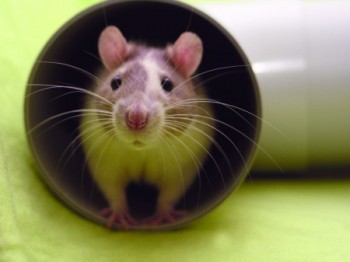
An experiment co-funded by the British Heart Foundation (BHF)[1] and conducted at Cambridge University involved rats being confined in ‘hypoxia chambers’ for two weeks, where they were forced to breathe air that had a low concentration of oxygen.[2]
The research was investigating whether eating vegetables rich in nitrates, (such as kale and spinach) could prevent some heart patients from developing a condition in which their organs do not receive enough oxygen. Eating green vegetables is already recommended as part of a healthy diet, but there is no reason why the researchers’ theory could not have been studied on volunteer patients. As well as sparing dozens of animals the misery of invasive experiments, a study on humans would have produced results that are relevant to our own species.
Animal suffering
- 40 male rats were given either nitrates (the substances found in some vegetables) or a saltwater solution.
- After four days, 20 of the animals were confined for 14 days in ‘hypoxia chambers’ in which the air contained just 13 per cent oxygen. This prolonged oxygen deprivation would no doubt have caused the rats terrible distress.
- Additional experiments used a further 48 rats, who were given either nitrates or plain water. These tests were designed to measure the effects of different doses of nitrates, and how the rats were affected over time.
- At the end of the study, the rats were killed, but the research paper describing the experiments does not mention how this was done. Common methods of killing rats in UK labs include decapitation and gassing.
Faulty science
- Some heart conditions cause blood to bypass the lungs, resulting in deoxygenated blood being pumped back around the body. In response, the body produces more red blood cells, but too many of these cause the blood to thicken and prevent it flowing through some smaller veins and arteries to supply organs with oxygen.
- When rats were deliberately kept in a low-oxygen environment, the researchers found that feeding them nitrates helped to prevent the blood from thickening, but there are several reasons why this result cannot be reliably translated to human patients:
- The rats used in the study did not suffer from heart defects but were artificially deprived of oxygen, providing only a very crude model of the condition suffered by human patients.
- The rats were fed a tightly-controlled, standardised diet, with sodium nitrate administered as an additive. This obviously bears little relation to nitrates being consumed naturally, as part of the varied diet that would be eaten by human patients.
- Even if the rats had been able to ‘model’ the human condition accurately, nitrates may not have the same effect on people. Key differences between species (as expressed in anatomy, organ structure and function, metabolism, chemical absorption and genetics) mean that people and rats respond to substances in different ways, and rats and humans metabolise nitrates differently. The research also cites other species differences in nitrate and nitric oxide levels between animals and humans.[3]
- The researchers themselves acknowledge that their experiments only lasted a short period of time. It is not clear whether the effects of the nitrates, even in rats, would have continued in the longer term.
- The researchers’ theory could easily and ethically have been trialled on people. Heart disease patients would not have been harmed by consuming nitrate-rich vegetables, and the effect of this could easily have been analysed using minimally invasive techniques such as blood tests. In fact, the researchers reference previous, far more relevant studies on dietary nitrate in humans.[4]
- Even if the researchers’ theory does turn out to be correct, it is unlikely that this would change the advice given to heart patients – and the population as a whole – which already includes consuming a wide variety of vegetables as part of a balanced diet to promote general health.
Update: Read our response to the British Heart Foundation
[1] The BHF declares that it helped fund the study at: https://www.bhf.org.uk/news-from-the-bhf/news-archive/2014/december/dietary-nitrates
[2] Ashmore T, Fernandez B, Evans C et al (2014). Suppression of erythropoiesis by dietary nitrate. The FASEB Journal article fj.14-263004
[3] Reports of the scientific committee for food: Nitrates http://ec.europa.eu/food/fs/sc/scf/reports/scf_reports_38.pdf
[4] Larsen F, Schiffer T, Borniquel S (2011). Dietary inorganic nitrate improves mitochondrial efficiency in humans. Cell Metab. 2011 Feb 2;13(2):149-59
